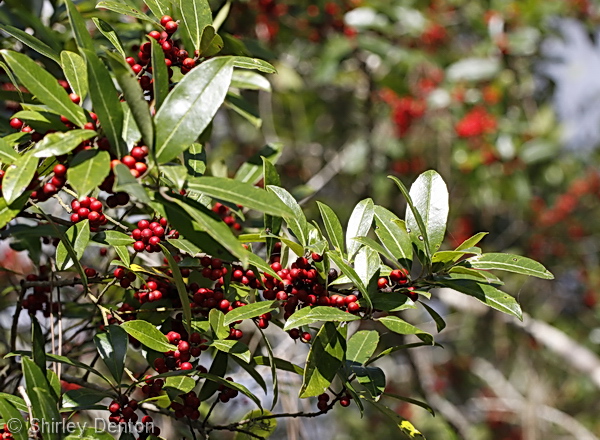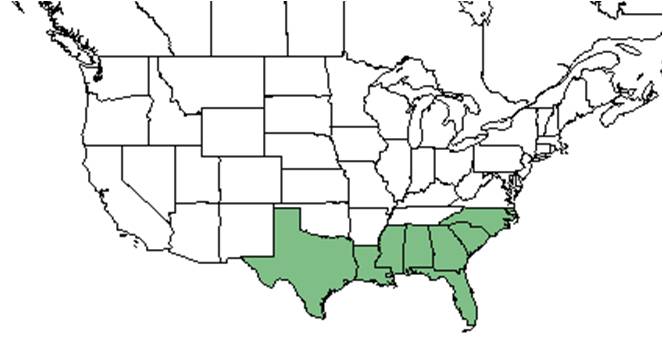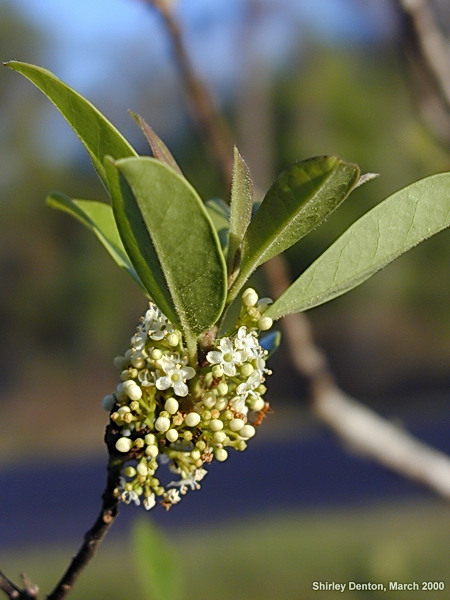Difference between revisions of "Ilex cassine"
(→Description) |
(→Description) |
||
| (38 intermediate revisions by 12 users not shown) | |||
| Line 3: | Line 3: | ||
{{taxobox | {{taxobox | ||
| name = Ilex cassine | | name = Ilex cassine | ||
| − | | image = | + | | image = Ilex_cass.jpg |
| − | | image_caption = | + | | image_caption = Photo by Shirley Denton (Copyrighted, use by photographer’s permission only), [http://www.shirleydenton.com/welcome Nature Photography by Shirley Denton] |
| regnum = Plantae | | regnum = Plantae | ||
| divisio = Magnoliophyta - Flowering plants | | divisio = Magnoliophyta - Flowering plants | ||
| Line 15: | Line 15: | ||
| binomial_authority = L. | | binomial_authority = L. | ||
| range_map = ilex_cass_dist.jpg | | range_map = ilex_cass_dist.jpg | ||
| − | | range_map_caption = Natural range of ''Ilex cassine'' from USDA NRCS [http:// | + | | range_map_caption = Natural range of ''Ilex cassine'' from USDA NRCS [http://plants.usda.gov/core/profile?symbol=HYJU Plants Database]. |
}} | }} | ||
| − | |||
| − | |||
| − | |||
| − | + | Common name: dahoon, dahoon holly, cassena<ref name=weakley>Weakley, A.S. 2020. Flora of the Southeastern United States. Edition of 20 October 2020. University of North Carolina at Chapel Hill, Chapel Hill, North Carolina.</ref> | |
| − | |||
| − | |||
| − | |||
| − | |||
| − | |||
| − | |||
| − | |||
| − | |||
| − | + | ==Taxonomic notes== | |
| + | Synonyms: ''Ilex cassine'' var. ''cassine''<ref name=weakley/> | ||
| − | + | Varieties: none<ref name=weakley/> | |
| − | + | ==Description== | |
| + | <!-- Basic life history facts such as annual/perrenial, monoecious/dioecious, root morphology, seed type, etc. --> | ||
| + | “Trees or shrubs, usually with imperfect flowers. Leaves simple, entire, serrate, dentate or crenate; stipules obsolete. Flowers axillary, solitary, fascicled or in cymes, 4-7 merous, 4-8 mm broad; petals united at the base, imbricate in bud; pistillate flowers usually with nonfunctional stamens; anthers opening lengthwise; stigmas 4-7, essentially sessile. Drupe red, black or rarely yellow or white. Seeds with hard, bony endocarp (pyrenes), often grooved or ribbed on the back, 4-7 in a fruit, 1 in each locule.”<ref name="Radford et al 1964">Radford, Albert E., Harry E. Ahles, and C. Ritchie Bell. Manual of the Vascular Flora of the Carolinas. 1964, 1968. The University of North Carolina Press. 679-81. Print.</ref> | ||
| − | + | "Large shrub or small tree, twigs minutely pubescent. Leaves coriaceous, lustrous above, pubescent beneath, at least on the midrib, evergreen, elliptic to obovate to oblanceolate or lanceolate, 2-10 cm long, 0.3-3 cm wide, remotely serrulate, serrate, or entire, often revolute. Pedicels usually densely canescent. Staminate flowers in short, axillary compound cymes, 4-merous. Pistillate flowers solitary or in 3-flowered, pedunculate cymes, in the leaf axils or from nodes just below the leaves; 4-merous. Drupe red, occasionally yellow or orange, lustrous, globose, 5-8 mm in diam.; pyrenes 4, irregularly grooved on the back, 4-5 mm long."<ref name="Radford et al 1964"/> | |
| − | + | ''I. cassine'' has a variable leaf shape that sometimes approaches ''I. myrtifolia''.<ref name=weakley/> | |
| − | + | ==Distribution== | |
| + | This plant is primarily a southeastern Coastal Plain endemic. Its range extends from southeast North Carolina to southern Florida and west to southeastern Texas. It also occurs in the Bahamas, Cuba, and Mexico.<ref name=weakley/> | ||
| − | + | ==Ecology== | |
| + | ===Habitat===<!--Natural communities, human disturbed habitats, topography, hydrology, soils, light, fire regime requirements for removal of competition, etc.--> | ||
| + | ''I. cassine'' has been found in loamy sands, marshy areas, mesic cypress-dominated thicket, cypress swamps, river banks, sweetbay-red maple woodland, pinelands, tropical evergreen hardwood forest, and shaded-mesic coastal hardwoods.<ref name="FSU"> Florida State University Herbarium Database. URL: http://herbarium.bio.fsu.edu. Last accessed: May 2021. Collectors: | ||
| + | Loran C. Anderson, George R. Cooley, R. J. Eaton, R.K. Godfrey, William T. Gillis, Brenda Herring, and Don Herring, O. Lakela, R. W. Long, and J D Ray. States and counties: Florida: Columbia, Dade, Jackson, Jefferson, Lake, Levy, Osceola, Santa Rosa, and Wakulla.</ref> It is also found in disturbed areas including frequently burned pinewoods and along boat ramps.<ref name="FSU"/> Associated species: ''Blechnum serrulatum, Zizania aquatic, Salix nigra'', and ''Lobelia cardinali''.<ref name="FSU"/> | ||
| − | Halictidae | + | ===Phenology=== <!--Timing off flowering, fruiting, seed dispersal, and environmental triggers. Cite PanFlora website if appropriate: http://www.gilnelson.com/PanFlora/ --> |
| + | ''I. cassine'' has been observed flowering in December.<ref>Nelson, G. [http://www.gilnelson.com/ PanFlora]: Plant data for the eastern United States with emphasis on the Southeastern Coastal Plains, Florida, and the Florida Panhandle. www.gilnelson.com/PanFlora/ Accessed: 12 DEC 2016</ref> | ||
| + | <!--===Seed dispersal===--> | ||
| + | <!--===Seed bank and germination===--> | ||
| + | <!--===Fire ecology===--> <!--Fire tolerance, fire dependence, adaptive fire responses--> | ||
| + | ===Pollination=== | ||
| + | ''Ilex cassine'' has been observed at the Archbold Biological Station to host bees such as ''Epeolus zonatus'' (family Apidae), plasterer bees from the Colletidae family such as ''Colletes brimleyi,'' and ''Hylaeus confluens'', sweat bees from the Halictidae family such as ''Augochlora pura, Augochlorella aurata, A. gratiosa, Lasioglossum placidensis,'' and ''Sphecodes heraclei'', wasps from the Leucospididae family such as ''Leucospis affinis, and L. slossonae'', leafcutting bees from the Megachilidae family such as ''Coelioxys sayi'', and ''Heriades leavitti'', spider wasps from the family Pompilidae such as ''Anoplius marginalis, A. parsoni, Aplopus mellipes, Episyron conterminus posterus, Paracyphonyx funereus,'' and ''Psorthaspis legata'', as well as thread-waisted wasps from the family Sphecidae such as ''Cerceris flavofasciata floridensis, C. rufopicta, Crabro hilaris rufibasis, Ectemnius decemmaculatus tequesta, Epinysson basilaris, Gorytes dorothyae ruseolus, Isodontia auripes, I. mexicana, Liris muesebecki, Oxybelus decorosum, O. emarginatus, O. laetus fulvipes, Tachysphex similis, Xysma ceanothae'' and wasps from the family Vespidae such as ''Mischocyttarus cubensis, Pachodynerus erynnis, P. nasidens, Parancistrocerus perennis anacardivora, P. salcularis rufulus, Polistes bahamensis, P. bellicosus, P. metricus, Stenodynerus lineatifrons, Vespula maculifrons, V. squamosa, Zethus slossonae,'' and ''Z. spinipes''.<ref name="Deyrup 2015">Deyrup, M.A. and N.D. 2015. Database of observations of Hymenoptera visitations to flowers of plants on Archbold Biological Station, Florida, USA.</ref> Additionally, ''I. cassine'' has been observed to be pollinated by ground nestng bees from the Andrenidae family such as ''Perdita bradleyi'', ''P. obscurata'', and ''P. townesi'', sweat bees from the Colletidae family such as ''Colletes banksi'' and ''C. distinctus'', and assassin bugs such as ''Zelus cervicalis'' (family Reduviidae).<ref>Discoverlife.org [https://www.discoverlife.org/20/q?search=Bidens+albaDiscoverlife.org|Discoverlife.org]</ref> | ||
| + | <!--===Herbivory and toxicology===--> | ||
| + | <!--===Diseases and parasites===--> | ||
| − | + | ==Conservation, cultivation, and restoration== | |
| − | + | ==Cultural use== | |
| + | The leaves can be used for tea as they contain caffeine.<ref> Fernald, et al. 1958. Edible Plants of Eastern North America. Harper and Row Publishers, New York.</ref> | ||
| − | + | ==Photo Gallery== | |
| − | + | <gallery widths=180px> | |
| − | + | File:Ilex_cass_fl2_S-Denton_NaturePhotobloom.jpg | <center> Flowers of ''Ilex cassine'', <p> Photo by Shirley Denton (Copyrighted, use by photographer’s permission only), [http://www.shirleydenton.com/welcome Nature Photography by Shirley Denton] </gallery> | |
| − | |||
| − | |||
| − | |||
| − | |||
| − | |||
| − | |||
| − | |||
| − | |||
| − | |||
| − | |||
| − | |||
| − | |||
| − | |||
| − | |||
| − | |||
| − | |||
| − | |||
| − | |||
| − | |||
| − | |||
| − | |||
| − | |||
| − | |||
| − | |||
| − | |||
| − | |||
| − | |||
| − | |||
| − | |||
| − | |||
| − | |||
| − | |||
| − | |||
| − | |||
| − | |||
| − | |||
| − | |||
| − | |||
| − | |||
| − | |||
| − | |||
| − | |||
| − | |||
| − | |||
| − | |||
| − | |||
| − | |||
| − | |||
| − | |||
| − | |||
| − | |||
| − | |||
| − | |||
| − | |||
| − | |||
| − | |||
| − | |||
| − | |||
| − | |||
| − | |||
| − | |||
| − | |||
| − | |||
| − | |||
| − | |||
| − | |||
| − | |||
| − | |||
| − | |||
| − | |||
| − | |||
==References and notes== | ==References and notes== | ||
Latest revision as of 13:34, 2 June 2023
| Ilex cassine | |
|---|---|

| |
| Photo by Shirley Denton (Copyrighted, use by photographer’s permission only), Nature Photography by Shirley Denton | |
| Scientific classification | |
| Kingdom: | Plantae |
| Division: | Magnoliophyta - Flowering plants |
| Class: | Magnoliopsida - Dicotyledons |
| Order: | Celastrales |
| Family: | Aquifoliaceae |
| Genus: | Ilex |
| Species: | I. cassine |
| Binomial name | |
| Ilex cassine L. | |

| |
| Natural range of Ilex cassine from USDA NRCS Plants Database. | |
Common name: dahoon, dahoon holly, cassena[1]
Contents
Taxonomic notes
Synonyms: Ilex cassine var. cassine[1]
Varieties: none[1]
Description
“Trees or shrubs, usually with imperfect flowers. Leaves simple, entire, serrate, dentate or crenate; stipules obsolete. Flowers axillary, solitary, fascicled or in cymes, 4-7 merous, 4-8 mm broad; petals united at the base, imbricate in bud; pistillate flowers usually with nonfunctional stamens; anthers opening lengthwise; stigmas 4-7, essentially sessile. Drupe red, black or rarely yellow or white. Seeds with hard, bony endocarp (pyrenes), often grooved or ribbed on the back, 4-7 in a fruit, 1 in each locule.”[2]
"Large shrub or small tree, twigs minutely pubescent. Leaves coriaceous, lustrous above, pubescent beneath, at least on the midrib, evergreen, elliptic to obovate to oblanceolate or lanceolate, 2-10 cm long, 0.3-3 cm wide, remotely serrulate, serrate, or entire, often revolute. Pedicels usually densely canescent. Staminate flowers in short, axillary compound cymes, 4-merous. Pistillate flowers solitary or in 3-flowered, pedunculate cymes, in the leaf axils or from nodes just below the leaves; 4-merous. Drupe red, occasionally yellow or orange, lustrous, globose, 5-8 mm in diam.; pyrenes 4, irregularly grooved on the back, 4-5 mm long."[2]
I. cassine has a variable leaf shape that sometimes approaches I. myrtifolia.[1]
Distribution
This plant is primarily a southeastern Coastal Plain endemic. Its range extends from southeast North Carolina to southern Florida and west to southeastern Texas. It also occurs in the Bahamas, Cuba, and Mexico.[1]
Ecology
Habitat
I. cassine has been found in loamy sands, marshy areas, mesic cypress-dominated thicket, cypress swamps, river banks, sweetbay-red maple woodland, pinelands, tropical evergreen hardwood forest, and shaded-mesic coastal hardwoods.[3] It is also found in disturbed areas including frequently burned pinewoods and along boat ramps.[3] Associated species: Blechnum serrulatum, Zizania aquatic, Salix nigra, and Lobelia cardinali.[3]
Phenology
I. cassine has been observed flowering in December.[4]
Pollination
Ilex cassine has been observed at the Archbold Biological Station to host bees such as Epeolus zonatus (family Apidae), plasterer bees from the Colletidae family such as Colletes brimleyi, and Hylaeus confluens, sweat bees from the Halictidae family such as Augochlora pura, Augochlorella aurata, A. gratiosa, Lasioglossum placidensis, and Sphecodes heraclei, wasps from the Leucospididae family such as Leucospis affinis, and L. slossonae, leafcutting bees from the Megachilidae family such as Coelioxys sayi, and Heriades leavitti, spider wasps from the family Pompilidae such as Anoplius marginalis, A. parsoni, Aplopus mellipes, Episyron conterminus posterus, Paracyphonyx funereus, and Psorthaspis legata, as well as thread-waisted wasps from the family Sphecidae such as Cerceris flavofasciata floridensis, C. rufopicta, Crabro hilaris rufibasis, Ectemnius decemmaculatus tequesta, Epinysson basilaris, Gorytes dorothyae ruseolus, Isodontia auripes, I. mexicana, Liris muesebecki, Oxybelus decorosum, O. emarginatus, O. laetus fulvipes, Tachysphex similis, Xysma ceanothae and wasps from the family Vespidae such as Mischocyttarus cubensis, Pachodynerus erynnis, P. nasidens, Parancistrocerus perennis anacardivora, P. salcularis rufulus, Polistes bahamensis, P. bellicosus, P. metricus, Stenodynerus lineatifrons, Vespula maculifrons, V. squamosa, Zethus slossonae, and Z. spinipes.[5] Additionally, I. cassine has been observed to be pollinated by ground nestng bees from the Andrenidae family such as Perdita bradleyi, P. obscurata, and P. townesi, sweat bees from the Colletidae family such as Colletes banksi and C. distinctus, and assassin bugs such as Zelus cervicalis (family Reduviidae).[6]
Conservation, cultivation, and restoration
Cultural use
The leaves can be used for tea as they contain caffeine.[7]
Photo Gallery
Flowers of Ilex cassine, Photo by Shirley Denton (Copyrighted, use by photographer’s permission only), Nature Photography by Shirley Denton
References and notes
- ↑ 1.0 1.1 1.2 1.3 1.4 Weakley, A.S. 2020. Flora of the Southeastern United States. Edition of 20 October 2020. University of North Carolina at Chapel Hill, Chapel Hill, North Carolina.
- ↑ 2.0 2.1 Radford, Albert E., Harry E. Ahles, and C. Ritchie Bell. Manual of the Vascular Flora of the Carolinas. 1964, 1968. The University of North Carolina Press. 679-81. Print.
- ↑ 3.0 3.1 3.2 Florida State University Herbarium Database. URL: http://herbarium.bio.fsu.edu. Last accessed: May 2021. Collectors: Loran C. Anderson, George R. Cooley, R. J. Eaton, R.K. Godfrey, William T. Gillis, Brenda Herring, and Don Herring, O. Lakela, R. W. Long, and J D Ray. States and counties: Florida: Columbia, Dade, Jackson, Jefferson, Lake, Levy, Osceola, Santa Rosa, and Wakulla.
- ↑ Nelson, G. PanFlora: Plant data for the eastern United States with emphasis on the Southeastern Coastal Plains, Florida, and the Florida Panhandle. www.gilnelson.com/PanFlora/ Accessed: 12 DEC 2016
- ↑ Deyrup, M.A. and N.D. 2015. Database of observations of Hymenoptera visitations to flowers of plants on Archbold Biological Station, Florida, USA.
- ↑ Discoverlife.org [1]
- ↑ Fernald, et al. 1958. Edible Plants of Eastern North America. Harper and Row Publishers, New York.
